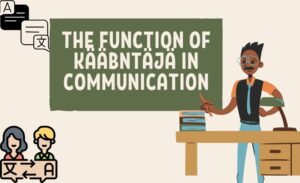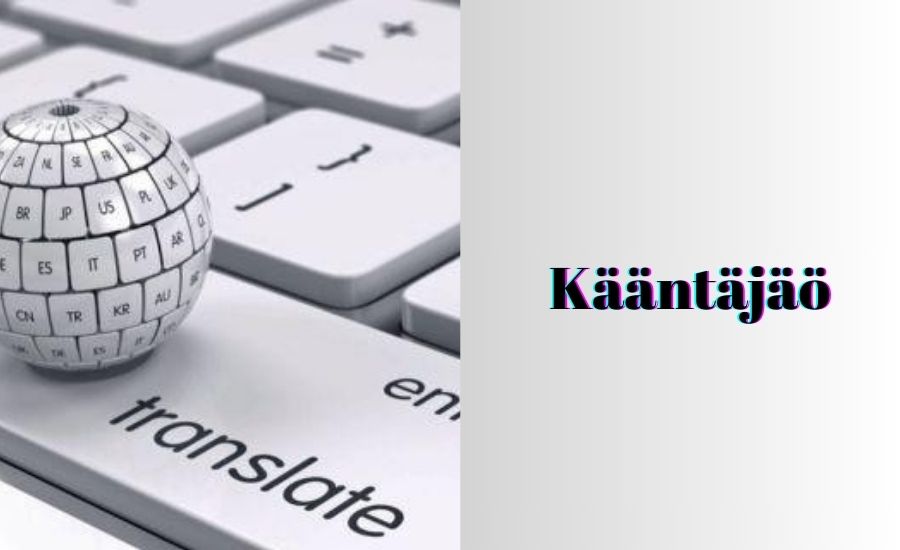Within the vast field of linguistics, a new phrase has been discovered recently that has captivated scholars and enthusiasts of the language. The phrase “Kaabntaja” has stirred a sensation of wonder and curiosity when people ponder the meaning behind it and its sources.
Join us on an exploration to decode the mystery of Kääbntäjä. Through the course, we’ll discover its significance, various manifestations, and central importance in current society.
What is Kääbntäjä?
Kaabntaja is believed to be a word that is not real, most likely due to a typo or misspelling that caused an accidental adventure into the world ofct. It is actually “Kaantaja,” a Finnish word that “translates to “translator.”
The findings highlight the essential role translators play in connecting languages and enhancing global communication.Translators are charged with transmitting messages across different languages and ensuring that they preserve the original meaning, tone, meaning, and specifics in their work.
Source of Kääbntäjä
The word “Kaabntaja” stems from a “mistake “or misspelling of the correct term “Kaantaja.” The error leads to an “exciting investigation into the role of translators in breaking down the language barrier.
The accidental invention of “Kääbntäjä” highlights “the critic “‘s importance of accuracy and meticulousness in translation. This mistake reminds translators of the difficulties in ensuring precision and clarity in their work.
The Function of Kääbntäjä in Communication

Translators, also known as Kaantaja or Kaantaja in Finnish, are key players in the world of communication. They energetically connect linguistic barriers to communicate complex concepts such as cultural nuances, subtleties, and feelings. The role of translators is crucial in increasing global connectivity and aiding in the sharing of information.
Translators work in a variety of fields, including literature, law, business, and even technology. They diligently ensure that information is relayed efficiently and across different languages. Their work goes beyond simple translation and includes capturing the meaning of the text, its character, and the meaning of the content.
Importance of Kääbntäjä
The importance of translators goes beyond simple translation. It demonstrates the need for accurate communications in the modern world of interconnectedness. Translators protect a country’s cultural heritage, catalyze trade and commerce across borders, and advocate for global peace.
They are indispensable because they allow access to a vast array of knowledge from around the world and cultural riches that otherwise would not be accessible. By bridging the gap between languages, translators promote cross-cultural interaction, strengthen diplomatic bonds, and facilitate the spread of information and innovations.
Types of Kääbntäjä
Although “Kääbntäjä” is a fiction “al term, “translators specialize in various fields, including:
Legal Translators: These professionals specialize in translating legal documents to ensure the precise translation of legal terms and concepts. Their expertise includes legal agreements, contracts, court papers, and more.
Medical Translators: Focusing on medical documentation, these translators assure precise and clear communication of medical data. They manage the patient’s information, research records, pharmaceutical data, and medical communication.
Technical Translators: They translate technical documentation, such as manuals, to ensure that the technical details are simple to understand. They also work on user guides, technical user specifications, Engineering documents, and software documentation.
Literary Translators: They are committed to the literary genre, and capture the character, tone and nuance. They translate poems, novels, plays, and other works of literature while preserving the original’s aesthetic and impression.
You May Also Like: Ontpresscom-Freshupdates
The Significance of Kääbntäjä in Today’s World
In today’s connectoday’sironment, the role of translation is crucial in several key areas:
- Global Business: Translators are crucial to facilitate communications and transactions in various cultures and languages. They assist businesses with expansion to new areas, introducing localization of their products and services, and keeping in touch with international customers and partners.
- International Relations: The translation process is essential for communication between international and diplomatic entities to ensure that messages are correctly transmitted. Translators play an essential role in negotiating treaties, agreements, and international gatherings, helping to break down cultural and linguistic obstacles.
- Cultural Exchange: By making films, literature, and other literary works available to people in different languages, translators foster understanding and appreciation for diverse cultures. Translators conserve and spread culture and promote worldwide cultural diversity.
- Education: Translators offer additional access to education materials in various languages, facilitating multilingual educational programs. They allow educators and students to get access to textbooks, research studies, online classes, and other educational materials across languages.
Who to Learn Kääbntäjä
Anyone interested in culture, language, and communications can discover the realm of Kaantaja (translation) and its significance. Whether you’re a scholar of languages or a professional, getting a better understanding of translation can benefit you greatly.
To become a translator, one must learn numerous languages and understand the contexts, cultural nuances, and nuances that influence language use. Anyone who wants to be a translator could enroll in translation studies programs, take part in immersion courses for language, and practice translating various texts.
Ability Required for Kääbntäjä
A good translator (Kaantaja) will possess these qualities:
Language Proficiency: Experience at least two languages and understand the grammar, vocabulary, and idiomatic phrases. Translators need to speak fluently in the language of origin and that used to convey accurately the significance.
Cultural Awareness: Awareness of the cultural and social subtleties affecting language and communications. Translators need to be knowledgeable about both languages’ contexts and cultural aspects to warrant that translations are precise and appropriately culturally based.
Attention to Detail: The capability to accurately communicate the meaning of the text and its tone with no errors. Translators should carefully and diligently examine their work’s accuracy and reliability.
Analytical Skills: Reading and understanding complex texts and expressing them clearly in a different language. Translators have to study the original text, comprehend the meaning of it and its purpose, and decide on the accurate way to convey it in the language of the intended audience.
Why Kääbntäjä Matters in Global Communication
“Kaabntaja” underscores “the crucible “and the significance of accurate translation in global communication. It helps to foster understanding and connection across many cultural and language barriers.
Translators remove the barriers to communication between people with different backgrounds, understanding and communicating efficaciously. They are crucial for international diplomacy, global business, and cultural exchange. They facilitate the exchange of information and thoughts.
Dare’s Faced by Kääbntäjä
Translators encounter several challenges, including:
Cultural Nuances: Understanding and communicating accurately the meaning of idioms and cultural references that may not have exact translations into the language of the intended audience. Translators need to be able to deal with cultural differences to warrant that meanings are conveyed in a way sensitive to cultural differences.
Language Complexity: The challenge of managing a complex language, such as syntax, grammar, and semantics. Translators should be adept at the intricate details of both the source’s and target language to provide accurate translations.
Contextual Understanding: Translators must conserve the context of the text and its meaning when translating. They must be aware of the context surrounding the source text and find efficient ways to communicate accurate information in the language of the intended audience.
Time Constraints: MTo meets tight deadlines while maintaining the highest accuracy and high quality. Translators must often be efficient and quickly balance speed with accuracy to satisfy clients’ needs.
Tools and Assets for Kääbntäjä
Translators make use of various tools and resources that can benefit them in their job, such as:
Computer-Assisted Translation (CAT) Software: The tools assist translators in suggesting translations and storing and storing translation memories. The CAT software improves effectiveness and reliability by allowing translators to reuse previously translated texts.
Machine Translation: Automated systems that create the initial translations that human translators improve. While machines can process massive amounts of text quickly, human oversight is required to assure precision and accuracy.
Translation Memories: Databases that hold texts that have been previously translated that benefit rise consistency and efficacy.
Online Resources: Dictionaries, glossaries, and other internet tools provide information on linguistics and culture. Translators use these tools to find phrases, find examples of usage, and learn about cultural contexts.
The Future of Kääbntäjä
Translation’s future isTranslations by advancements in technology, AI, and machine learning. Although computers can aid the process of translating, human translators are essential to procure insight into culture and deeper language.
AI-driven software is becoming increasingly advanced, however the human factor is essential to capture subtleties in language and making sure that translations are precise as well as culturally appropriate. In the future, we will probably see increased collaboration between translators and AI and technology that enhances humans’ abilities to produce superior-quality translations faster.
Conclusion
Human translators are crucial in capturing cultural differences and ensuring accurate communication. Even with technological advances in translation, the future depends on the cooperation between AI and human experts. The synergy between AI and human expertise will improve the quality and speed of translation by combining the strengths of each to fulfill the increasing requirements of global communication.
FAQs
Q: What is Kääntäjä?
A: Kaantaja is a name for a translator. It emphasizes the significance of translation in the world of communications.
Q: Why are human translators still needed despite AI advancements?
A: Human translators are crucial as they can comprehend the cultural subtleties, contexts, and nuances that computers often fail to grasp.
Q: How does technology impact the translation industry?
A: Technologies, specifically AI and machine learning, increase the accuracy and efficiency of translations. However, human oversight is essential to warrant the accuracy of translations and their cultural significance.
Q: What is the future of the translation industry?
A: The next decade will likely witness an effort to collaborate between human translators and AI and technology to efficiently provide high-quality translations.
Q: How do translation memories help translators?
A: Translation memories save previous translations, assisting translators in maintaining consistency and effectiveness in various tasks.
Read More: Who-Is-Andrew-Santino-Wife
